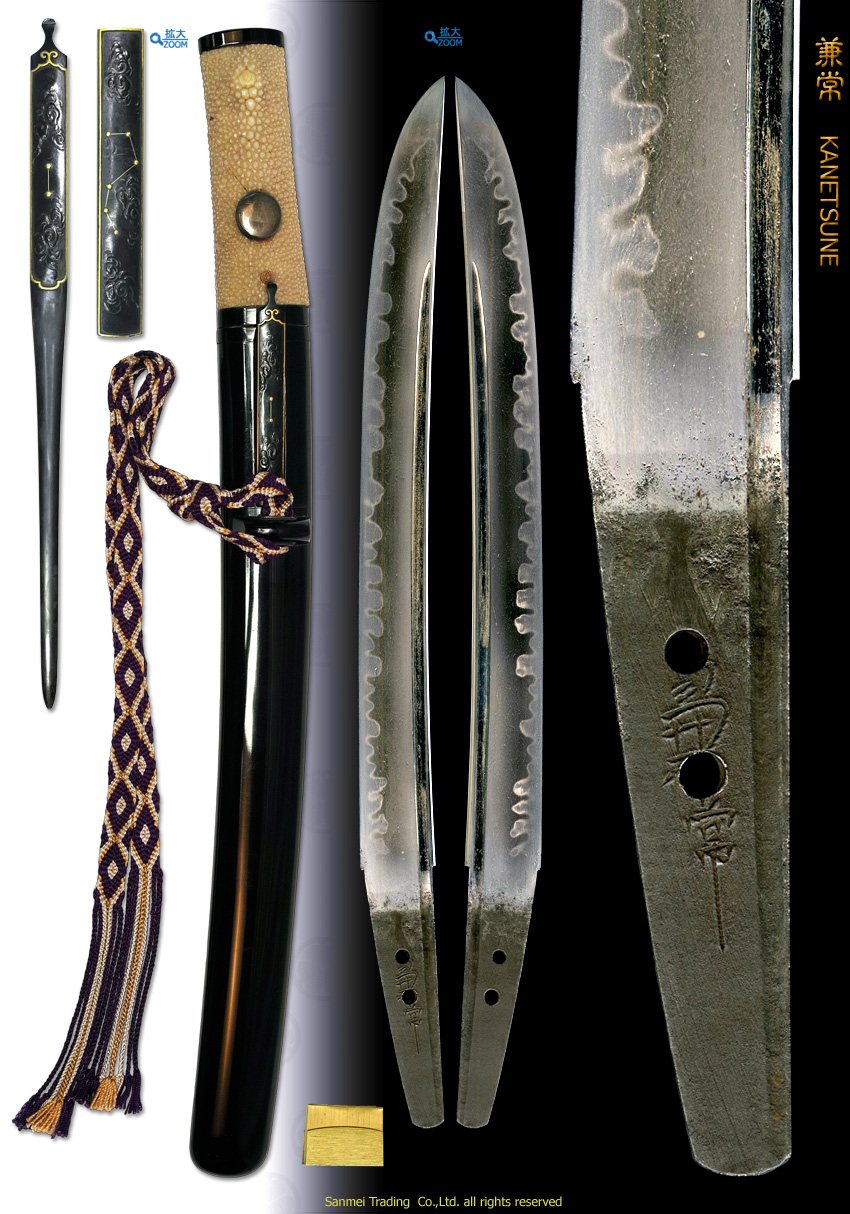with)Black Ro-iro lacquered scabbard Aikuchi-style Tanto Koshirae
Length of cutting edge 31.2cm Curvature 0.4cm Width of base 29.9mm Thickness of base 5.5mm
Forging pattern (kitae hada) : Kitae hada is Mokume-hada mixing with Itame-hada. Conspicuous streaming ware of Masame appears along quenching temper line. Whitish Utsuri of reflecting hard metal granules appears on surface.
Tempering pattern (hamon) : Quenching area is covered with a bit on stronger side of Ko-Nie "hard metal granules", mixture of large Gunome, waist slim Choji-ha, Notch of an arrow shape or Box-shape varies shape in different angles. The interior of temper where is filled with deep mist granules of Nioi, where works with frequent ASHI that emits toward cutting edge, floating YOU and intensive Sunagashi streams across ASHI. Hamon is vividly clear with rich activity of fine Nie and refreshing Nioi.
Temper of tip (boshi) : Temper of tip is a slanting Gunome, undulating Notrare then medium circle turns back deeply to form Jizou-boshi like a side view of Jizou stone stature.
Tang (Nakago) : Fish bottom (Funazoko) shape Nakago is UBU in original slightly curved. Two retaining holes of Mekugiana. "Higaki" crossing file marks in superb taste of patina in 450 years. There is a little mass contoured on the cutting side whereas the back ridge of Nakago is flat. Shallow double-bevelled (Kurijiri) heel shape. There is classical chiselled two character inscription KANETSUNE 兼常.
The roots of KANETSUNE 兼常 is reportedly originated from 千手院 school in Yamato domain then moved to Seki in Mino domain. The substantial founder of KANETSUNE 兼常 is back to Eikyo (1429-) era in early Muromachi period.
KANETSUNE 兼常 belonged to Nara 奈良派 among 7 groups of Shichi-to-sei 七頭制 (note). The oldest existing work with the date of year is Eikyo 3 (1431) and it's families had been in existence in generations throughout Muromachi period.
Some of KANETSUNE families had moved to the other regions and the most distinguished KANETSUNE 兼常 was MASATSUNE 政常 in Owari domain (now in Nagoya).
The subject stirring blade is a typical work by the KANETSUNE 兼常 which was designed for the battle filed in full of Samurai majesty spirit during the Warning States of period. To make judgement from it's inscription of TSUNE 常, it assumes that this KANETSUNE is supposed to a person who moved to Owari then changed his smith name to MASATSUNE 政常.
Upper pointed curve was designed for fast draw, Hirazukuri-construction works well for cutting through the openings of armor, Itame forging of functional mixture was designed for durable construction, Typical Hamon of Gunome and Clove outline shows Mino features being quenched for the supreme sharp performance.
Here is an extra large Tanto holding wide Mihaba that stands firmly on base with fully swelling Fukura and harmonized Soe-hi which is chiseled away to the Nakago, these features distinguish it's excellent condition being treasured in multiple decades of generations in 450 years and deeply admired for an typical example of the legitimate Mino tradition.
with) Balck Ro-iro lacquered Aikuchi style tanto Koshirae
(click HERE for entire Koshirae FRONT and HERE for BACK/click HERE for each fitting)
- Fuchi/Kashira : Buffalo horn
- Menuki : The sun and the crescent moon design, silver ground, polish surface
- Kozuka/Kogai : An asterism design, Shakudo Nanako-ji, Takabori carving, gold Iroe, unsigned
- Tsuka : White rayskin Dashi-same
An old good polish/Condition scale: excellent (using a scale of mint-excellent-very good-good-fair-poor)
(note) Shichi-to-sei 七頭制 is composed of Zenjo 善定, San'ami 三阿弥, Nara, 奈良, Tokuin 得印, Tokunaga 得永, Ryoken 良賢, Muroya 室屋
reference data :
SUZUKI Takuo, SUGIURA Yoshiyuki, Muromachi-ki Mino-to no Kenyu, Ribun shuppan, 2006




